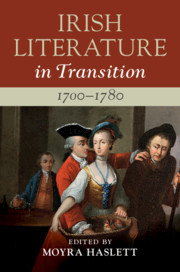Book contents
- Irish Literature in Transition, 1700–1780
- Irish Literature in Transition
- Irish Literature in Transition, 1700–1780
- Copyright page
- Contents
- Illustrations
- Contributors
- Series Preface
- General Acknowledgements
- Introduction
- Part I Starting Points
- Part II Philosophical and Political Frameworks
- Part III Local, National, and Transnational Contexts
- Part IV Gender and Sexuality
- Part V Transcultural Contexts
- Chapter 15 The Popular Criminal Narrative and the Development of the Irish Novel
- Chapter 16 Gaelic Influences and Echoes in the Irish Novel, 1700–1780
- Chapter 17 New Beginning or Bearer of Tradition? Early Irish Fiction and the Construction of the Child
- Part VI Retrospective Readings
- Index
Chapter 15 - The Popular Criminal Narrative and the Development of the Irish Novel
from Part V - Transcultural Contexts
Published online by Cambridge University Press: 28 February 2020
- Irish Literature in Transition, 1700–1780
- Irish Literature in Transition
- Irish Literature in Transition, 1700–1780
- Copyright page
- Contents
- Illustrations
- Contributors
- Series Preface
- General Acknowledgements
- Introduction
- Part I Starting Points
- Part II Philosophical and Political Frameworks
- Part III Local, National, and Transnational Contexts
- Part IV Gender and Sexuality
- Part V Transcultural Contexts
- Chapter 15 The Popular Criminal Narrative and the Development of the Irish Novel
- Chapter 16 Gaelic Influences and Echoes in the Irish Novel, 1700–1780
- Chapter 17 New Beginning or Bearer of Tradition? Early Irish Fiction and the Construction of the Child
- Part VI Retrospective Readings
- Index
Summary
The popular eighteenth-century genre of criminal biography is recognised today for its contribution to the development of the English novel, but its impact on Irish literature has not been explored to the same extent. However, criminal biographies were common fare for Irish readers in the 1700–1780 period. This chapter situates the criminal narrative, a form combining biographical and fictional content and drawing on the picaresque tradition, as an important subtext for the first Irish novels. It surveys the consumption of these texts in Ireland and their treatment of Irish settings and characters. Close readings are offered of a late-seventeenth-century fiction, The Irish Rogue (1690), and a mid-eighteenth-century collection of biographies, John Cosgrave’s A Genuine History of the Lives and Actions of the Most Notorious Irish Highwaymen, Tories and Rapparees (1747). Both can be singled out for their representations of nationality and travel, which enable them to undercut conventional associations between the Irish and criminality. Such rogue tales, it is argued, expanded the repertoire of Irish fiction, establishing characteristic strategies of plotting and characterisation which paved the way for later novels.
- Type
- Chapter
- Information
- Irish Literature in Transition, 1700–1780 , pp. 307 - 323Publisher: Cambridge University PressPrint publication year: 2020

